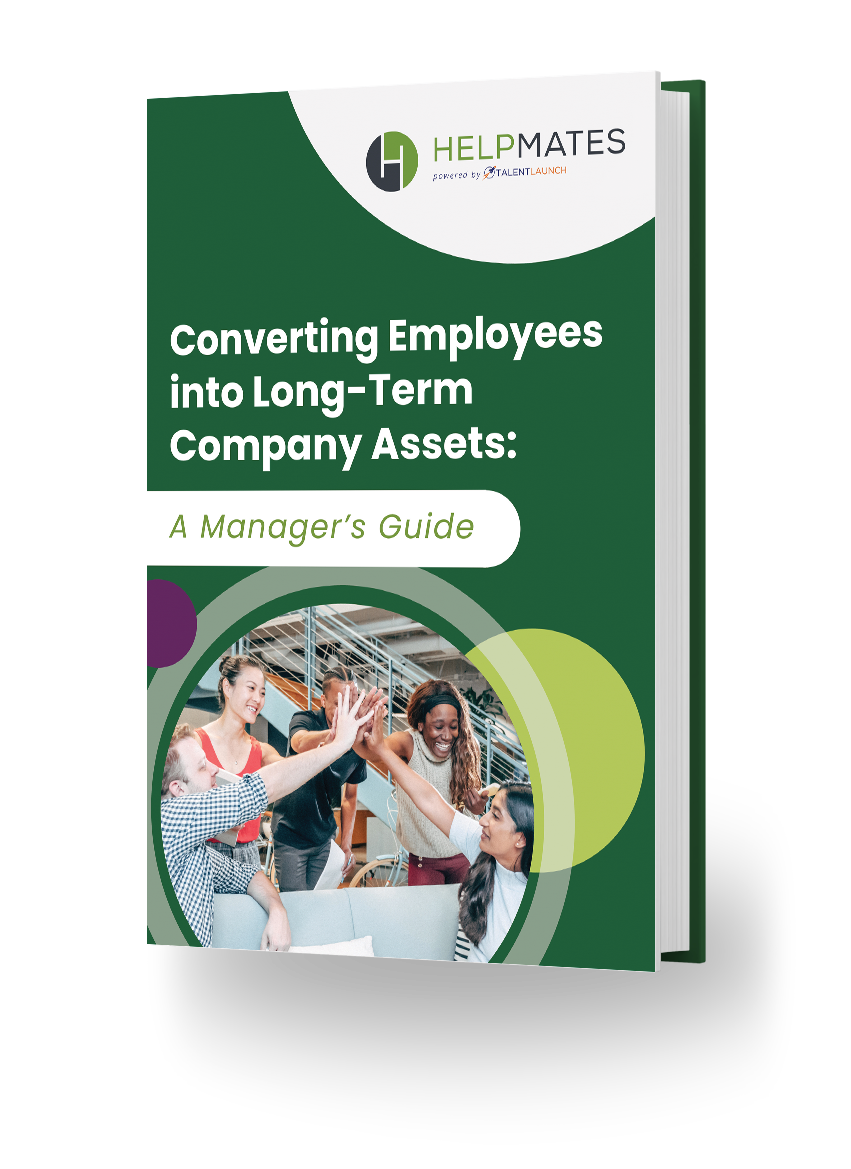If one of your biggest workforce challenges is finding — and retaining — dependable employees, you’ll want to bookmark this blog. This is the first post in our series on recruitment and retention strategies. It all starts with making a great first impression with your new hires, so today we’re sharing how to set them up for success from Day 1 with employee onboarding best practices.
But first, let’s discuss the importance of a retention strategy for your company’s long-term success.
Why Employee Retention Is Important

Turnover can significantly impact your company’s productivity and bottom line. Consider these statistics:
- 52%: majority of turnover in the first year of employment1
- 52%: number of employees planning to look for a new job this year2
- 33%: average percentage of a lost employee’s annual salary in turnover costs3
- Trillions: The number of dollars businesses lose every year due to voluntary employee turnover4
No matter how you slice it, turnover negatively impacts time, employee morale, and finances. Whether you manage a team of HR professionals, warehousing and distribution specialists, or customer service experts, a solid recruitment and retention strategy is key to driving organizational success.
The first step to transforming staff — from temporary to permanent — into valuable long-term assets begins with your new employee onboarding program.
Crafting a Comprehensive Onboarding Program
Your company has its recruiting and hiring process fine-tuned and running like a well-oiled machine. Case in point: you’ve just welcomed an outstanding new employee to the team in near record time.
But your work is just beginning.
The best employee onboarding experiences help lay the foundation for a motivated workforce that’s ready to contribute to your organization’s success. Here’s what to do next.

Design a structured orientation and onboarding process tailored to each department
A structured onboarding process is a well-planned and systematic approach to welcoming and integrating new employees into your organization, ensuring that they feel supported in their positions from day one.
One size does not fit all. In addition to general onboarding for your company, work closely with each department to develop personalized onboarding programs catering to the specific needs and responsibilities of each role.
Regardless of the department, a structured onboarding program includes standard components that apply to all new hires. This is called new hire orientation, and typically consists of:
- Welcoming and Introduction: A warm welcome and introduction to your company’s values, culture, and mission from HR and/or the hiring manager sets the tone for a positive onboarding experience.
- Company Policies and Procedures: Provide a thorough overview of your organization’s policies, procedures, and employee handbook to ensure compliance and set expectations.
- Benefits and Compensation: Explain the employee benefits package, including healthcare, retirement plans, reimbursements, and other perks offered by the company.
- IT and Security: Set up new employees with the necessary IT equipment, email, and access to company systems, while ensuring data security protocols are followed.
To tailor the onboarding process to each department, consider the following practices:
- Job Shadowing: Provide opportunities for new hires to shadow experienced employees in their department to observe real-world work processes and gain hands-on experience.
- Meet & Greet: Arrange meetings with key stakeholders and departments to understand the company’s organizational structure and team dynamics.
- Mentorship: Pair new employees with mentors within their department to offer guidance and support during the initial weeks or months.
- Department-Specific Policies: Highlight department-specific policies and procedures that might be different from the overall company guidelines.

Include team integration, role-specific training — and their first project
In our experience, a successful onboarding program goes beyond the standard and tailored components listed above. This is where you really start digging deep!
- Team integration activities foster collaboration and camaraderie. Encourage department-specific team-building activities to help new hires bond with their colleagues and gain a better understanding of the team dynamics.
- Role-specific training empowers employees with the knowledge and skills needed to confidently excel in their roles. Customize training sessions to address the unique skills and knowledge required for each role. For example:
- Customer service professionals: Product/service training, effective customer communication and conflict resolution, tools, and software.
- HR professionals: Company policies, regulations and compliance, HR software, employee recruitment, performance management, and benefits administration.
- Warehouse employees: health and safety procedures, inventory management, and equipment operation.
- Projects and Assignments. Assign department-specific projects or tasks that align with the new hire’s role, allowing them to apply their skills and contribute to the team’s goals right off the bat.

Set clear expectations from the start to align new hires with company values
We’ve found that the best employee onboarding experiences emphasize the importance of clear communication and expectations. Make sure to put it in writing. It could be as simple as a written expectations checklist that the employee can refer back to and track their progress.
For example:
Day 1: You will ______________.
Week 1: You will do x and understand X.
30 days: You will do x and understand X.
60 days: You will do x and understand X.
90 days: You will do x and understand X.
By setting transparent expectations from the beginning, new employees will understand their roles, performance goals, and how their contributions align with your company’s values and overall objectives.
This alignment fosters a sense of purpose and commitment among your long-term staff — which leads to higher retention.
Key Takeaways: Employee Onboarding Best Practices
- The best retention strategies begin with your new hire orientation and onboarding program.
- Employee retention is important because turnover can wreak havoc on productivity and profits.
- Your onboarding program should include a structured orientation, onboarding tailored to each department and role, and clear expectations.
Next Up: Employee Development Strategies
The next installment in our recruitment and retention strategies series will discuss the benefits of providing continuous employee training and development. You’ll learn to identify and close skills gaps, individual support tactics, and how to drive continuous improvement and innovation.
Can’t wait? Get the complete guide!





